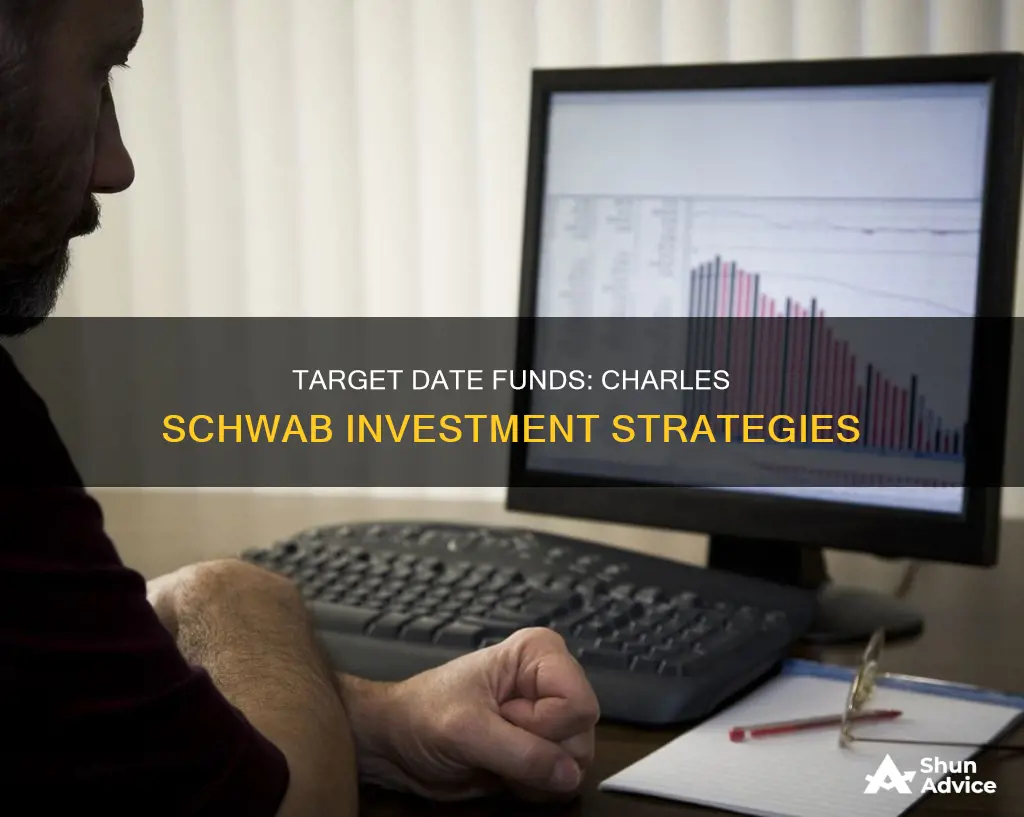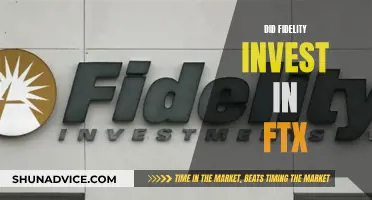
Target date funds are a type of mutual fund that offers a simple, all-in-one investment solution for those saving for retirement. These funds are designed to provide a diversified portfolio that automatically adjusts its asset allocation over time, becoming more conservative as the investor's target retirement date approaches. Charles Schwab, a well-known investment firm, offers Target Index Funds that are managed by Schwab Asset Management. These funds are designed to provide capital appreciation and income, with a diverse asset mix across equity, fixed income, and cash equivalents. The funds are reallocated annually to reduce risk and help investors meet their retirement goals. With no top-level fees and no transaction fees, Schwab's Target Date Funds are competitively priced, allowing your investment to go further. Before investing, it is important to consider your risk tolerance, personal circumstances, and complete financial situation.
What You'll Learn

Schwab Target Index Funds
The funds are reallocated annually to become more conservative over time to help meet investors' retirement goals. The starting allocation of 97% equity and 3% fixed income and cash equivalents changes over time until it reaches 44% equity and 56% fixed income and cash equivalents at the target retirement date. At this time, each fund will continue to reduce its allocation to equity investments for an additional 20 years, reaching its most conservative policy allocation of 28% equity and 72% fixed income and cash equivalents. At this point, the allocation is intended to remain static.
At the target retirement date, it is assumed that investors will no longer contribute assets to the fund and, depending on each individual’s financial circumstances, will begin to gradually withdraw assets invested in the fund over time. The funds are competitively priced with zero top-level fees and no transaction fees so that your investment goes further.
In addition to age and anticipated retirement date, investors should consider their risk tolerance, personal circumstances, and complete financial situation, as well as any other investment options before investing in a particular target date fund. It is important to remain aware of your allocation and check in regularly so that you can make updates as your circumstances change.
Mid-Cap Funds: Smart Investment Timing for Optimal Returns
You may want to see also

Target date funds vs ETFs
Target-date funds and ETFs (exchange-traded funds) are two very popular investment options. Both have their advantages and disadvantages, and it is important to understand the differences between the two before investing.
Target-Date Funds
Target-date funds are a type of mutual fund that provides a "set it and forget it" approach to investing. These funds are designed to simplify retirement investing and are often used as an investor's single portfolio. The asset allocation is automatically adjusted to become more conservative as the target date, usually retirement, approaches. This is known as the fund's glide path. For example, a target fund with a target date of 2040 will be composed of approximately 40% stocks, 53% bonds, and 7% cash investments. The fund will continue to increase its allocation of fixed income until 2060, when it will reach a static allocation of 25% stocks, 68% bonds, and 7% cash investments.
The benefits of target-date funds include diversification, professional management, and simplicity. They are also competitively priced with zero top-level fees and no transaction fees. However, target-date funds often have higher expense ratios than ETFs due to the active management involved. They also lack customization and may not align perfectly with an investor's personal preferences and risk tolerance.
ETFs
ETFs are passively managed and track a specific market index, such as the S&P 500. They provide broad exposure to the market and lower costs. ETFs are available as both mutual funds and exchange-traded funds, providing investors with flexibility in how they invest. Mutual fund ETFs can be purchased directly from the fund company or through a brokerage account, while index ETFs can be bought and sold on stock exchanges throughout the trading day.
The advantages of ETFs include broad market exposure, low cost, and simplicity. However, they lack flexibility and may not adapt well to changing market conditions. Additionally, since ETFs track the performance of a specific index, they often don't beat the market.
Both target-date funds and ETFs have their merits, and the choice between the two depends on the investor's goals, risk tolerance, and level of engagement. Target-date funds are suitable for those who want a hands-off, automated investment approach, while ETFs offer more control and customization.
Best Mutual Funds to Invest in the USA
You may want to see also

Pros and cons of target date funds
Target date funds are a popular choice for investors, especially those investing for retirement. They are designed to be the only investment vehicle that an investor needs to save for retirement. Here are some of the pros and cons of target date funds:
Pros
- Simplicity: Target date funds are simple to understand and invest in. Investors do not need to worry about rebalancing their portfolio annually or changing holdings as they get older.
- Tinkering prevention: The all-in-one nature of target date funds prevents excessive tinkering, which can reduce investor returns due to excessive trading commissions and portfolio turnover.
- Low expense ratios: Target date funds have low expense ratios compared to actively managed funds.
Cons
- Flawed assumptions: The one-size-fits-all nature of target date funds can leave investors exposed during unusual economic conditions. For example, during a period of rising inflation and higher interest rates, historically conservative fixed-income assets may underperform.
- Lack of holistic view: Target date funds only consider one variable – a person's expected retirement date – when constructing a portfolio. Other factors such as an investor's assets outside of the target date fund (e.g. real estate, insurance policies, Social Security, etc.) should also be considered when designing an appropriate portfolio.
- Opaque fee structure: While most target date funds have low expense ratios, some have less transparent fee structures. There may be additional fees charged by the underlying funds that are not reflected in the fund's annual report.
Mutual Funds vs. ETFs: Which is the Better Investment Option?
You may want to see also

How to choose a target date fund
Target date funds are a type of asset allocation fund where the mix of securities and asset classes, such as equities and fixed income, gradually shift as your target date for needing the money (usually retirement) draws near. The funds are designed to help you avoid one of the most common investing pitfalls: failing to adjust your portfolio for your changing financial needs over time.
When choosing a target date fund, it is important to consider the following:
- Risk tolerance: Understand your risk tolerance and choose a fund with an asset allocation that matches it. The asset allocation of a target date fund will become more conservative over time, but it is important to ensure that you are comfortable with the level of risk you are taking on.
- Target retirement date: Consider your anticipated retirement date and choose a fund that aligns with it. Target date funds are typically offered in five-year increments (e.g., 2025, 2030, 2035, etc.), and you should select the fund that is closest to your expected retirement year.
- Personal circumstances: Evaluate your personal circumstances, including your age, financial situation, and any other investment options you may have. Consider factors such as your income, expenses, and financial goals when choosing a target date fund.
- Investment goals: Be clear about your investment goals and choose a fund that aligns with them. Target date funds are often used as an investor's single portfolio when investing for retirement, so ensure that the fund you choose is suitable for your long-term goals.
- Fund performance: Research the historical performance of the target date fund to get a sense of its potential returns. Compare the performance of different funds to identify those that have consistently delivered strong returns.
- Fees and expenses: Understand the fees and expenses associated with the target date fund, such as management fees, distribution fees, and other operating expenses. Consider the expense ratio, which represents the fund's total annual operating expenses as a percentage of average net assets.
- Fund composition: Look into the composition of the target date fund to understand the types of investments it holds. Target date funds typically invest in a mix of stocks, bonds, and cash equivalents, and it is important to ensure that the fund's investment strategy aligns with your goals and risk tolerance.
By considering these factors, you can make an informed decision when choosing a target date fund that best suits your financial needs and goals.
Best ELSS Funds to Invest in India: Smart Picks
You may want to see also

Target date funds vs S&P500
Target-date funds and S&P 500 Index funds are both popular investment options, but they have some key differences. Here is a detailed comparison between the two:
Overview
Target-date funds are mutual funds designed for retirement planning. The investment strategy of these funds automatically adjusts over time, becoming more conservative as the investor approaches retirement age. The fund's asset allocation is based on the investor's risk tolerance, which changes as they get older. Target-date funds are often used as an all-in-one portfolio solution, and the investor doesn't need to worry about rebalancing their portfolio as they age.
On the other hand, the S&P 500 Index fund is a type of index fund that tracks the performance of the S&P 500 stock market index. Index funds are passively managed, meaning they aim to replicate the returns of the underlying index by holding a basket of securities that match the composition and weighting of the index. These funds give investors broad exposure to the market and are known for their simplicity and low costs.
Advantages of Target-Date Funds
- Diversification: Target-date funds typically invest in a mix of asset classes, providing broad diversification within a single investment vehicle.
- Professional management: Fund managers handle the allocation and rebalancing of assets in the portfolio, guided by the investor's target date and risk profile.
- Simplicity: Target-date funds are a "set it and forget it" investment solution, as they automatically adjust the asset allocation over time without requiring manual intervention.
Disadvantages of Target-Date Funds
- Higher fees: Target-date funds often have higher expense ratios than index funds due to the active management involved in adjusting the asset allocation over time.
- Lack of customization: Investors have limited control over the specific holdings and asset allocation of target-date funds, which may not perfectly align with their personal investment preferences.
- One-size-fits-all approach: Target-date funds follow a preset glide path based on the target retirement date, which may not suit every investor's individual risk tolerance and investment goals.
Advantages of S&P 500 Index Funds
- Broad market exposure: S&P 500 Index funds provide exposure to a diverse range of securities within a single investment vehicle, including 500 large-cap companies from various sectors.
- Low costs: Index funds typically have lower expense ratios than actively managed funds due to their passive investment strategy and lower operational costs.
- Simplicity: Index funds offer a straightforward, passive approach to investing, eliminating the need for investors to select individual securities.
Disadvantages of S&P 500 Index Funds
- Lack of flexibility: Index funds are designed to track a specific index and lack the flexibility to adapt to changing market conditions. When the market declines, index funds will also decline in value.
- Limited potential for outperformance: Since index funds mirror the performance of their target index, they often don't beat the market.
Both target-date funds and S&P 500 Index funds have their advantages and disadvantages. Target-date funds are ideal for investors seeking a hands-off, automated investment solution that adjusts its asset allocation over time to match their changing risk profile. On the other hand, S&P 500 Index funds offer broad market exposure, low costs, and simplicity but lack the flexibility to adapt to market conditions and may not provide market-beating returns. The best choice depends on an investor's financial goals, risk tolerance, and desired level of engagement with their investments.
DFA Funds: Smart Investment, Diversified Returns
You may want to see also
Frequently asked questions
Charles Schwab target date funds are professionally managed according to your approximate target date for retirement. They are competitively priced with zero top-level fees and no transaction fees, so your investment goes further. The funds are automatically adjusted over time and become more conservative as the target date gets closer.
Consider investing in the fund closest to your target retirement date, and ensure that the asset allocation matches your risk tolerance, personal circumstances, and complete financial situation. It’s important to remain aware of your allocation and check in regularly so that you can make updates as your circumstances change.
You can call 866-877-0134 to speak with an investment consultant.







